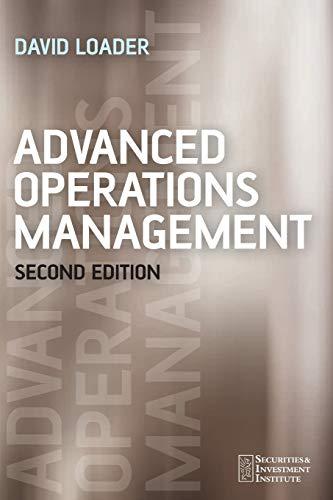Answered step by step
Verified Expert Solution
Question
1 Approved Answer
please show work. I am having a hard time understanding 1) Dr. Dulbit Drillum, partner in the dental firm of Drillum, Fillum, and Billum, exchanged
please show work. I am having a hard time understanding 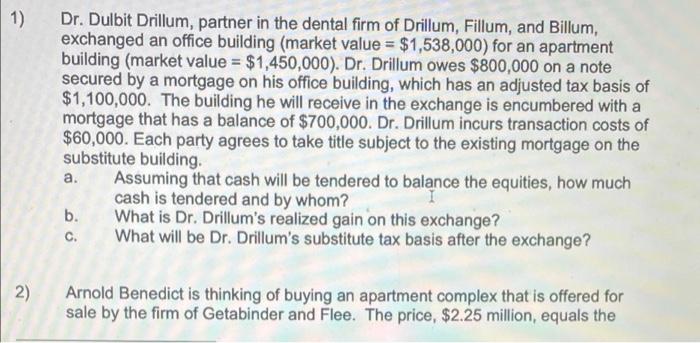
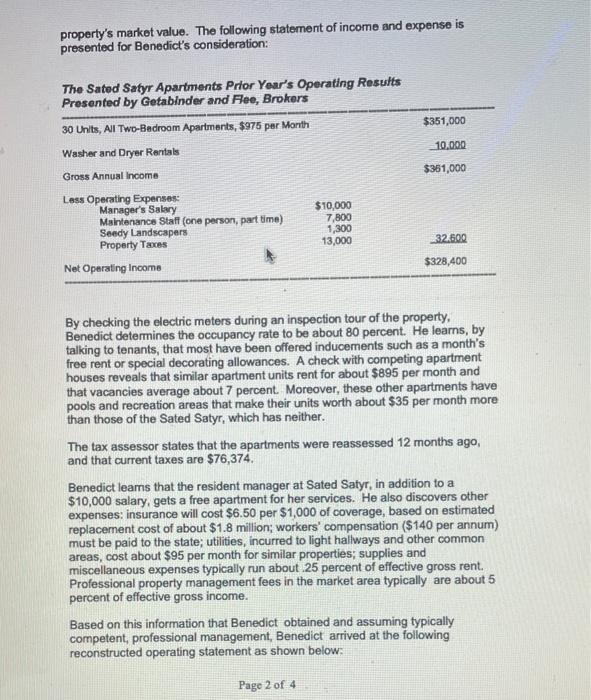
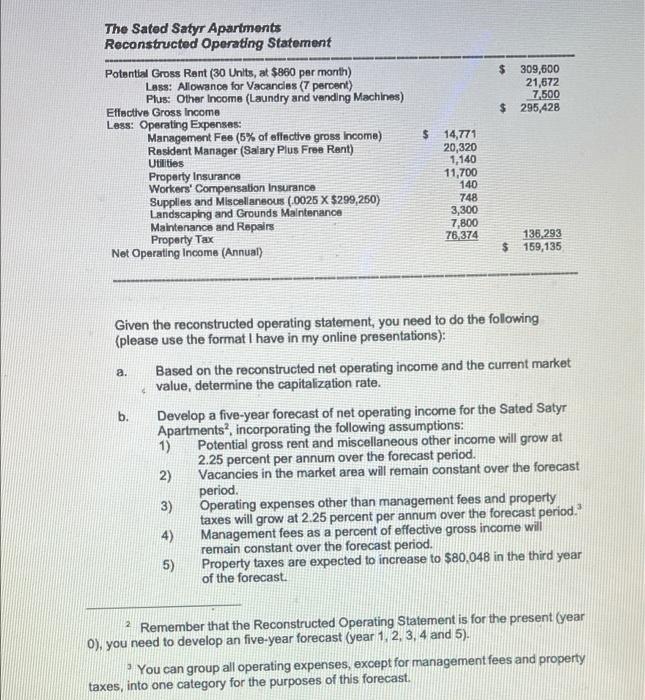
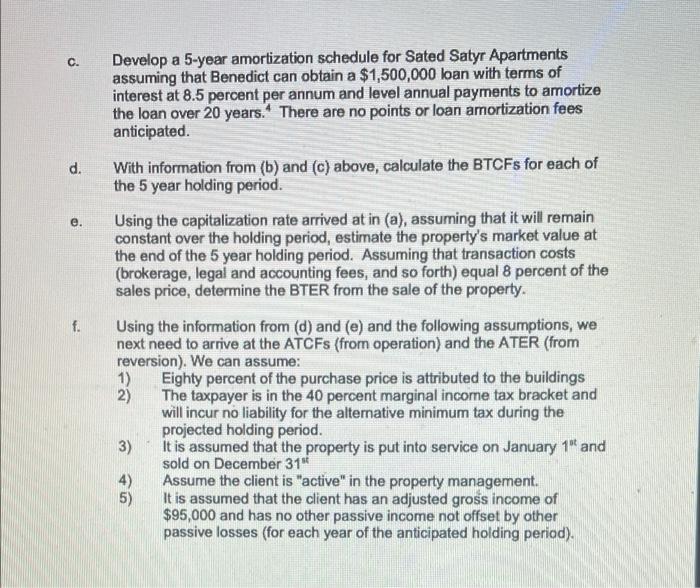
1) Dr. Dulbit Drillum, partner in the dental firm of Drillum, Fillum, and Billum, exchanged an office building (market value = $1,538,000) for an apartment building (market value = $1,450,000). Dr. Drillum owes $800,000 on a note secured by a mortgage on his office building, which has an adjusted tax basis of $1,100,000. The building he will receive in the exchange is encumbered with a mortgage that has a balance of $700,000. Dr. Drillum incurs transaction costs of $60,000. Each party agrees to take title subject to the existing mortgage on the substitute building a. Assuming that cash will be tendered to balance the equities, how much cash is tendered and by whom? I b. What is Dr. Drillum's realized gain on this exchange? c. What will be Dr. Drillum's substitute tax basis after the exchange? 2) Arnold Benedict is thinking of buying an apartment complex that is offered for sale by the firm of Getabinder and Flee. The price, $2.25 million, equals the property's market value. The following statement of income and expense is presented for Benedict's consideration: The Sated Satyr Apartments Prior Year's Operating Results Presented by Getabinder and Fee, Brokers 30 Units, All Two-Bedroom Apartments, $975 par Month $351,000 10,000 Washer and Dryer Rentals $361,000 Gross Annual Income Less Operating Expenses: Manager's Salary Maintenance Staff (one person, part time) Seedy Landscapers Property Taces Net Operating Income $10,000 7,800 1,300 13,000 32.600 $328,400 By checking the electric meters during an inspection tour of the property, Benedict determines the occupancy rate to be about 80 percent. He learns, by talking to tenants, that most have been offered inducements such as a month's free rent or special decorating allowances. A check with competing apartment houses reveals that similar apartment units rent for about $895 per month and that vacancies average about 7 percent. Moreover, these other apartments have pools and recreation areas that make their units worth about $35 per month more than those of the Sated Satyr, which has neither. The tax assessor states that the apartments were reassessed 12 months ago and that current taxes are $76,374. Benedict leams that the resident manager at Sated Satyr, in addition to a $10,000 salary, gets a free apartment for her services. He also discovers other expenses: insurance will cost $6.50 per $1,000 of coverage, based on estimated replacement cost of about $1.8 million; workers' compensation ($140 per annum) must be paid to the state; utilities, incurred to light hallways and other common areas, cost about $95 per month for similar properties; supplies and miscellaneous expenses typically run about 25 percent of effective gross rent. Professional property management fees in the market area typically are about 5 percent of effective gross income. Based on this information that Benedict obtained and assuming typically competent, professional management, Benedict arrived at the following reconstructed operating statement as shown below: Page 2 of 4 The Sated Satyr Apartments Reconstructed Operating Statement $ 309,600 21,572 7,500 $ 295,428 Potential Gross Rent (30 Units, at $860 per month) Lass: Allowance for Vacancies (7 percent) Plus: Other Income (Laundry and vending Machines) Effective Gross Income Less: Operating Expenses: Management Fee (5% of effective gross Income) Resident Manager (Salary Plus Free Rent) Utilities Property Insurance Workers' Compensation Insurance Supplies and Miscellaneous (,0025 X $299,250) Landscaping and Grounds Maintenance Maintenance and Repairs Property Tax Net Operating Income (Annual) $ 14,771 20,320 1,140 11,700 140 748 3,300 7,800 76.374 136,293 159,135 $ a. b. Given the reconstructed operating statement, you need to do the following (please use the format I have in my online presentations): Based on the reconstructed net operating income and the current market value, determine the capitalization rate. Develop a five-year forecast of net operating income for the Sated Satyr Apartments, incorporating the following assumptions: 1) Potential gross rent and miscellaneous other income will grow at 2.25 percent per annum over the forecast period. 2) Vacancies in the market area will remain constant over the forecast period. 3) Operating expenses other than management fees and property taxes will grow at 2.25 percent per annum over the forecast period." 4) Management fees as a percent of effective gross income will remain constant over the forecast period. 5) Property taxes are expected to increase to $80,048 in the third year of the forecast. Remember that the Reconstructed Operating Statement is for the present year o), you need to develop an five-year forecast (year 1, 2, 3, 4 and 5). 19 You can group all operating expenses, except for management fees and property taxes, into one category for the purposes of this forecast. C. Develop a 5-year amortization schedule for Sated Satyr Apartments assuming that Benedict can obtain a $1,500,000 loan with terms of interest at 8.5 percent per annum and level annual payments to amortize the loan over 20 years. There are no points or loan amortization fees anticipated. d. e. f. With information from (b) and (c) above, calculate the BTCFs for each of the 5 year holding period. Using the capitalization rate arrived at in (a), assuming that it will remain constant over the holding period, estimate the property's market value at the end of the 5 year holding period. Assuming that transaction costs (brokerage, legal and accounting fees, and so forth) equal 8 percent of the sales price, determine the BTER from the sale of the property. Using the information from (d) and (e) and the following assumptions, we next need to arrive at the ATCFs (from operation) and the ATER (from reversion). We can assume: 1) Eighty percent of the purchase price is attributed to the buildings 2) The taxpayer is in the 40 percent marginal income tax bracket and will incur no liability for the alternative minimum tax during the projected holding period. 3) It is assumed that the property is put into service on January 1" and sold on December 31 4) Assume the client is "active" in the property management. 5) It is assumed that the client has an adjusted gross income of $95,000 and has no other passive income not offset by other passive losses (for each year of the anticipated holding period) 



Step by Step Solution
There are 3 Steps involved in it
Step: 1

Get Instant Access to Expert-Tailored Solutions
See step-by-step solutions with expert insights and AI powered tools for academic success
Step: 2

Step: 3

Ace Your Homework with AI
Get the answers you need in no time with our AI-driven, step-by-step assistance
Get Started


